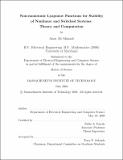Non-monotonic Lyapunov functions for stability of nonlinear and switched systems : theory and computation
Author(s)
Ahmadi, Amir Ali
DownloadFull printable version (1.075Mb)
Other Contributors
Massachusetts Institute of Technology. Dept. of Electrical Engineering and Computer Science.
Advisor
Pablo A. Parrilo.
Terms of use
Metadata
Show full item recordAbstract
Lyapunov's direct method, which is based on the existence of a scalar function of the state that decreases monotonically along trajectories, still serves as the primary tool for establishing stability of nonlinear systems. Since the main challenge in stability analysis based on Lyapunov theory is always to nd a suitable Lyapunov function, weakening the requirements of the Lyapunov function is of great interest. In this thesis, we relax the monotonicity requirement of Lyapunov's theorem to enlarge the class of functions that can provide certicates of stability. Both the discrete time case and the continuous time case are covered. Throughout the thesis, special attention is given to techniques from convex optimization that allow for computationally tractable ways of searching for Lyapunov functions. Our theoretical contributions are therefore amenable to convex programming formulations. In the discrete time case, we propose two new sucient conditions for global asymptotic stability that allow the Lyapunov functions to increase locally, but guarantee an average decrease every few steps. Our first condition is nonconvex, but allows an intuitive interpretation. The second condition, which includes the first one as a special case, is convex and can be cast as a semidenite program. We show that when non-monotonic Lyapunov functions exist, one can construct a more complicated function that decreases monotonically. We demonstrate the strength of our methodology over standard Lyapunov theory through examples from three different classes of dynamical systems. First, we consider polynomial dynamics where we utilize techniques from sum-of-squares programming. Second, analysis of piecewise ane systems is performed. Here, connections to the method of piecewise quadratic Lyapunov functions are made. (cont.) Finally, we examine systems with arbitrary switching between a finite set of matrices. It will be shown that tighter bounds on the joint spectral radius can be obtained using our technique. In continuous time, we present conditions invoking higher derivatives of Lyapunov functions that allow the Lyapunov function to increase but bound the rate at which the increase can happen. Here, we build on previous work by Butz that provides a nonconvex sucient condition for asymptotic stability using the first three derivatives of Lyapunov functions. We give a convex condition for asymptotic stability that includes the condition by Butz as a special case. Once again, we draw the connection to standard Lyapunov functions. An example of a polynomial vector field is given to show the potential advantages of using higher order derivatives over standard Lyapunov theory. We also discuss a theorem by Yorke that imposes minor conditions on the first and second derivatives to reject existence of periodic orbits, limit cycles, or chaotic attractors. We give some simple convex conditions that imply the requirement by Yorke and we compare them with those given in another earlier work. Before presenting our main contributions, we review some aspects of convex programming with more emphasis on semidenite programming. We explain in detail how the method of sum of squares decomposition can be used to efficiently search for polynomial Lyapunov functions.
Description
Thesis (S.M.)--Massachusetts Institute of Technology, Dept. of Electrical Engineering and Computer Science, 2008. This electronic version was submitted by the student author. The certified thesis is available in the Institute Archives and Special Collections. Includes bibliographical references (p. 87-90).
Date issued
2008Department
Massachusetts Institute of Technology. Department of Electrical Engineering and Computer SciencePublisher
Massachusetts Institute of Technology
Keywords
Electrical Engineering and Computer Science.